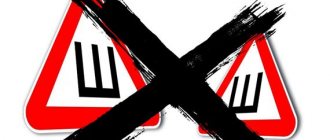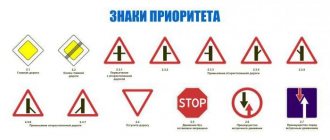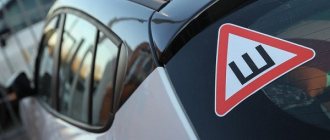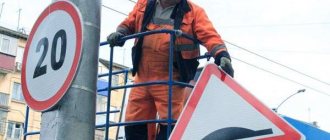According to the amendments to the “Road Rules”, effective from 04/04/17, in Russia it is mandatory to use the “Spikes” sign on cars with installed studded winter tires.
However, not all car owners know about this and the vast majority drive without this sign, which is fraught with certain troubles for them with traffic police inspectors.
From this article you will learn:
- What determines the mandatory installation
- What is it for?
- Penalty for the sign "Spikes"
- Where to put the “Spikes” sign on a car
- What should the “Spikes” sign be like according to GOST
- Absence of the “Spikes” sign in an accident
What determines the mandatory installation
The mandatory installation of the “Spikes” sign on a car is determined by clause 7.15 of the “amendments to the traffic rules” dated April 4, 2021, which lists the list of malfunctions for which the operation of the car is prohibited. The following is written verbatim in paragraph 7.15:
There are no identification marks that must be installed in accordance with paragraph 8 of the Basic Provisions for the admission of vehicles to operation.
At the same time, in paragraph 8 of the Basic Provisions for the admission of vehicles to operation, the following is written verbatim:
The following identification marks must be installed on vehicles: - “Spikes” - in the form of an equilateral triangle of white color with the apex up with a red border, in which the letter “Ш” is inscribed in black.
That is, driving without a “Spikes” sign on a car with installed studded winter tires is considered illegal from 2021. By the way, now everyone can easily identify a car by license plate using the current database.
Why do you need to glue the “Spikes” sign?
We carefully studied the traffic rules as of 2021, and this is what we found out: the sticker must be positioned in such a way that it is visible to drivers of other cars. The minimum length of the triangle edge is 20 cm. The minimum width of the red border is 2 cm.
Therefore, the question of the relevance of the “Ш” sign disappears in itself.
The main purpose of the “Ш” sign is to inform other drivers about the need to keep their distance. In more accessible language, this sticker belongs to the “Identification” category, and is installed to warn other road users to keep their distance. The fact is that studded tires reduce the braking distance of the car, and during emergency braking, road users behind may not have time to stop. This suggests the conclusion that the presence of spikes increases the likelihood of an accident, especially in the absence of appropriate identification marks.
The presence of the “Ш” badge helps to avoid damage caused to other vehicles. In addition, the “Ш” sticker has enormous legal force, as it relieves the driver of liability for damage to other cars by spikes. Surely, many have heard that at high speeds, spikes can fly out and, in the worst case scenario, cause serious injuries to other drivers.
The absence of the “Ш” sticker can become a serious obstacle when passing a scheduled technical inspection. Recently, passing maintenance without the appropriate badge is impossible. In other words, if you arrived at the MOT on studded tires and forgot to put a sticker, you will not receive a ticket. Therefore, we advise you to take an interest in the question of where to hang the spike badge on the car.
The absence of a sticker may force a traffic police officer to stop your car. There are two types of violations: you drive with spikes, but did not stick a badge, or you continue to operate the car despite the absence of a technical inspection ticket.
Due to imperfect legislation, incidents often occur when a car is driven into from behind, but there is no sticker on it indicating the presence of studded tires, and traffic police officers assign mutual responsibility for the accident. This situation is not at all pleasing, as it hits your pocket hard.
What is it for?
It must be said that the need to install a sign is determined not only by legislation, but also by common sense.
Today, the choice of winter tires is huge; non-studded tires (Velcro) are chosen by an increasing number of car owners. However, even in big cities there are many situations where studded winter tires have a shorter braking distance than Velcro tires.
A clearly visible "Spike" sign can actually warn the driver behind you that the stopping distance may be much shorter than he expects. That is, the presence of a sign is, in fact, an additional factor that reduces accidents on the roads. There is no need to neglect them.
Penalty for not having a “Sh” sticker
There are many rumors among domestic motorists regarding penalties for the absence of a warning sign “Ш”. We decided to bring some clarity to this issue.
So, all issues related to the identification mark “Ш” are regulated by paragraph 8 of the OP - every driver who has equipped a car with studded tires must install the corresponding sticker in the specified place. Where is the thorn sign placed on a car? We already said above that this could be a rear window, body or bumper.
We hope we have clearly explained that the traffic rules strictly regulate issues related to the installation of this sign.
As for penalties, the situation is as follows: for the absence of a “Ш” sticker, traffic police officers can punish drivers in accordance with Part 1 of Article 12.5, which provides for a fine of 500 rubles (in some cases a simple warning is possible).
Until 2021, drivers could challenge the fine they received, since paragraph OP and article 12.5 strongly contradicted each other. But this year, paragraph 8 was rewritten, and now the absence of the “Ш” sticker is positioned as a malfunction that prohibits the movement of the car.
Penalty for the sign "Spikes"
Since the absence of the “Spikes” sign is now considered a malfunction, according to Part 1 of Article 12.5 of the Administrative Code, traffic police inspectors have the right to impose a fine of 500 rubles on the car owner.
Literally, part 1 of Article 12.5 reads like this:
Driving a vehicle when there is a malfunction...
...incurs a warning or the imposition of an administrative fine in the amount of five hundred rubles.
That is, if the car owner is very lucky and the traffic police inspector is in a good mood, then he can count on a warning. But with a high probability we can say that there will be a fine.
Fine for not having a “Spikes” sign
Changes made to the Basic Provisions for the admission of vehicles to traffic regarding the use of the “Spikes” sign automatically added a corresponding clause to the Code of Administrative Offences. Thus, part 1 of Article 12.5 of the Code of Administrative Offenses now states that the fine for the absence of the “Spikes” sign is 500 rubles . At the same time, the law allows the replacement of a fine with a warning. The traffic police inspector can mitigate the sanction at his own discretion.
The possibility of getting off with a warning in no way makes the article on the need to put up a “Spikes” sign formal: the introduction of a fine means that legislators consider the problem serious and will insist on punishing persistent violators. We must not forget that a vehicle that does not meet the requirements of the Basic Provisions for the Admission of Vehicles to Participate in Road Traffic is prohibited from operating on public roads. At the same time, avoiding any troubles, be it a fine or compensation for damage caused to someone else’s car, is very simple: just buy or print out a sign yourself and stick it on the rear window of your car.
For reference: Federal Law No. 437-FZ, which entered into force in 2021, makes it possible to reduce the amount of the fine paid by half if the violator manages to pay it off within 20 days after the fine is issued. This 50% discount applies to a limited list of violations, but sanctions for the absence of the “Spikes” sign are included in this list. This means that if you take a responsible approach to your civic responsibilities, the fine for the “Spikes” sign will be only 250 rubles.
Where to put the “Spikes” sign on a car
Many car owners also often have a question: where to put the “Spikes” sign? It can be difficult to independently determine the place where it should be installed (there are many options - on the door or trunk lid, on the bumper, on the rear lid of the body, on the awning, some even glue it to a trunk attached to the roof rack).
It should be noted here that except for paragraph 8 of the “Basic provisions for the approval of vehicles for operation,” the location of the sign on the car is not specified by any other documents, including the “Road Rules.”
The following is written verbatim in paragraph 8 of the “Basic Provisions”:
...the sign must be installed at the rear of motor vehicles.
That is, the sign simply must be visible and clearly readable for those road users driving behind your car.
As for the sign sticker itself, you need to remember the following:
- Since the sign should be placed only for the winter (it is not needed in the summer), you need to keep in mind that the sign pasted in the fall will have to be removed in the spring. But this may not be so simple and can even lead to damage to the paint or the glass itself on the car if the wrong place is chosen.
- There are two types of signs - with glue on the front side of the sign and with glue on the back side of the sign. Accordingly, those signs that have glue on the front side are glued from the inside of the car, those on the back side are glued to the outside of the car.
- Signs are produced by many manufacturers; for many of them, the adhesive base can grip too tightly, which will create a lot of difficulties when peeling off the sign in the spring. On the inside of the car glass, its heating filaments can be damaged, and on the outside, even the paint on the car body can be damaged.
- To prevent this from happening, it is best to choose places where you know you won’t be able to damage the car. For example, car glass is perfect for any glue, since scraping off sign and glue residues from it will be much easier than from any other surface. However, if the sticker is supposed to be applied from the inside, it is necessary that there are no heating filaments on the glass.
- When sticking a sign on the car window, do not forget about visibility. The sign must be pasted in such a way that it does not block the view to the rear. The most optimal places for placement will be the upper corners of the rear window of the car. The top left corner works best because it interferes least with your view. The upper right corner can also be used if there are already some stickers in the upper left.
- Also, do not forget that many cars have tinted rear windows, so the sign pasted on the inside will be difficult to read. For tinted cars, an exterior sticker is more suitable. Also, a sign glued to the outside is convenient because you can ask to peel it off at any car wash in the spring.
- There are also a lot of options for “Spikes” signs for internal installation “on suction cups” and other “Velcro”. Here it must be said that the installation of such signs must be checked from time to time, since all these “Velcro” and “suction cups” tend to come off over time.
Installation of the Spikes sign according to traffic regulations
It was said above that the Studded Tires sign is necessary to warn other road users that the car is equipped with studded tires. The amendments to the traffic rules contain a rule stipulating that this sticker must be installed on the vehicle if the car has studded tires. The main purpose of putting a sign on a car is to warn drivers about the shortened braking distance and the need to maintain a maximum distance.
Where to glue
There is no strict standard for the placement of the badge, but the vehicle operating rules roughly indicate where to place the Spikes sign. The sticker should be placed on the rear window of the car (if we are talking about a passenger car), and it should be clearly visible to other road users. The exact location of the icon can be adjusted at your discretion and depending on the characteristics of the vehicle.
A motorist has the right to use not only a purchased badge, but also a homemade badge, which can be downloaded from the Internet and printed on a color printer. This attribute sticks well with double-sided tape, and the sign should be laminated first. There are other options for fixing the badge on the car, for example, using suction cups (then the triangle can be used many times and there will be no traces of glue left after removal).
- How to determine your bra size
- Chicken breast cutlets: recipes
- How to quickly stop heavy periods with pills and folk remedies
Dimensions of the sign according to GOST
If a car owner makes a triangle himself, he must adhere to certain traffic police requirements. According to GOST, the sign must:
- look like a white triangle with a red border and a black letter “Ш” in the center;
- be dense, for which the triangle is printed on special photographic paper (the optimal density indicator is 120-150);
- be glued in a place visible to other road users.
What are the dimensions of the Spikes sign according to GOST? Each cocked hat should be at least 20 centimeters, and the optimal width of the red frill is 10 times less than the side of the figure (at least 2 cm). As a rule, car dealerships sell stickers of the required size. There is no point in purchasing and gluing a small triangle, since legally it will not be considered valid, and the driver may be fined in this regard.
What should the “Spikes” sign be like according to GOST
It should be noted that in addition to the presence of the sign on the car, it is also necessary that it comply with GOST.
According to GOST, the “Spikes” sign must be an equilateral triangle of white color with a side measuring at least 20 cm, with a black letter “Ш” inscribed in it and a red border along the edges of at least 2 cm (10%) thick.
There are many different signs sold in stores and not all of them comply with GOST; when purchasing, it is better to check the length of the sides of the triangle with a ruler or tape measure.
You can also print the sign yourself; to do this, just download the picture from our website:
“Spikes” sign: dimensions according to GOST
The appearance of the “Spikes” warning sign is selected to make it as visible as possible to all road users. An equilateral triangle with a bright red border and a large black letter “Ш” on a white background was chosen as the basis for the image. At the same time, the state standard establishes the minimum dimensions of the sign and its elements:
- the length of the side of the triangle is at least 20 cm,
- the width of the red border is 1/10 of the length of the triangle (minimum 2 cm)
This format of the sign allows the use of its image on paper - plain or self-adhesive, as well as the choice of any size at the request of the car owner, but not less than the established minimums.
Absence of the “Spikes” sign in an accident
As for the responsibility of the driver of a car without an installed “Spikes” sign who is involved in an accident, the following should be said here:
In the vast majority of cases, the guilt of a driver who does not keep his distance and drives into the car in front is determined by the traffic police officers even when registering an accident.
However, the presence of the “Spikes” sign has now become mandatory and its absence on the back of the damaged vehicle may become an additional factor that the culprit of the accident can use to his advantage. And under a certain set of circumstances, even turn the case around in court in such a way that you become completely innocent.
The smartest thing to do is not to give the potential culprit of a possible accident such an excellent chance to confuse the matter, and stick the “Spikes” sign where it should be by law.
Is the spike sign required or not?
Despite the fact that studded tires are no longer exotic and are found on almost everyone, especially in the summer, about half of car owners stick the sign on.
However, this violates the “Basic provisions for the approval of vehicles for operation,” or more precisely, paragraph 8: the “Spikes” sign must be installed on a car with studded tires.
Paragraph 2.3.1 of the Traffic Regulations is also violated, according to which the driver is obliged to ensure that the condition of the car complies with the “General Provisions”. From 2021, the absence of a sticker is a reason for a ban on using a car.
Please note: if in the summer the driver “changes his shoes” to non-studded tires, the sign will have to be removed.











